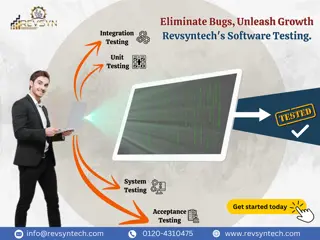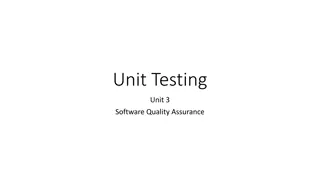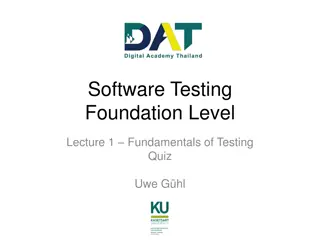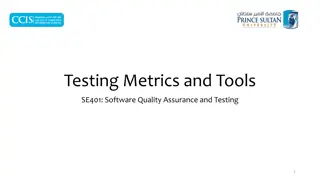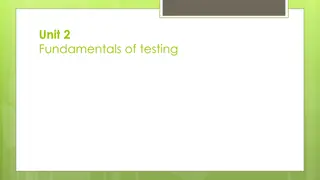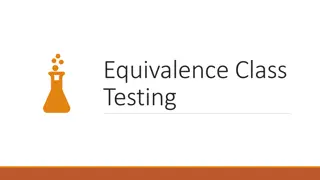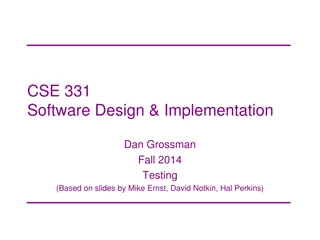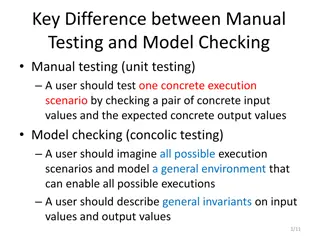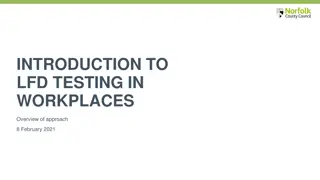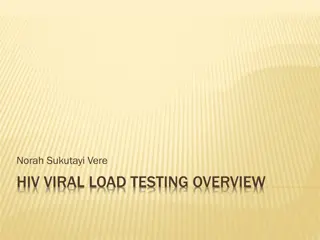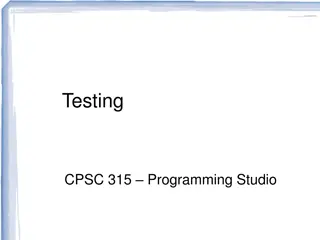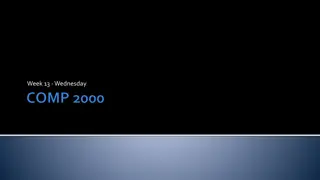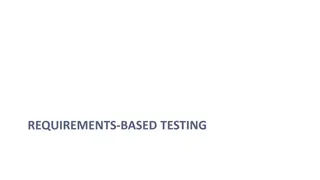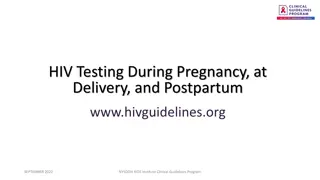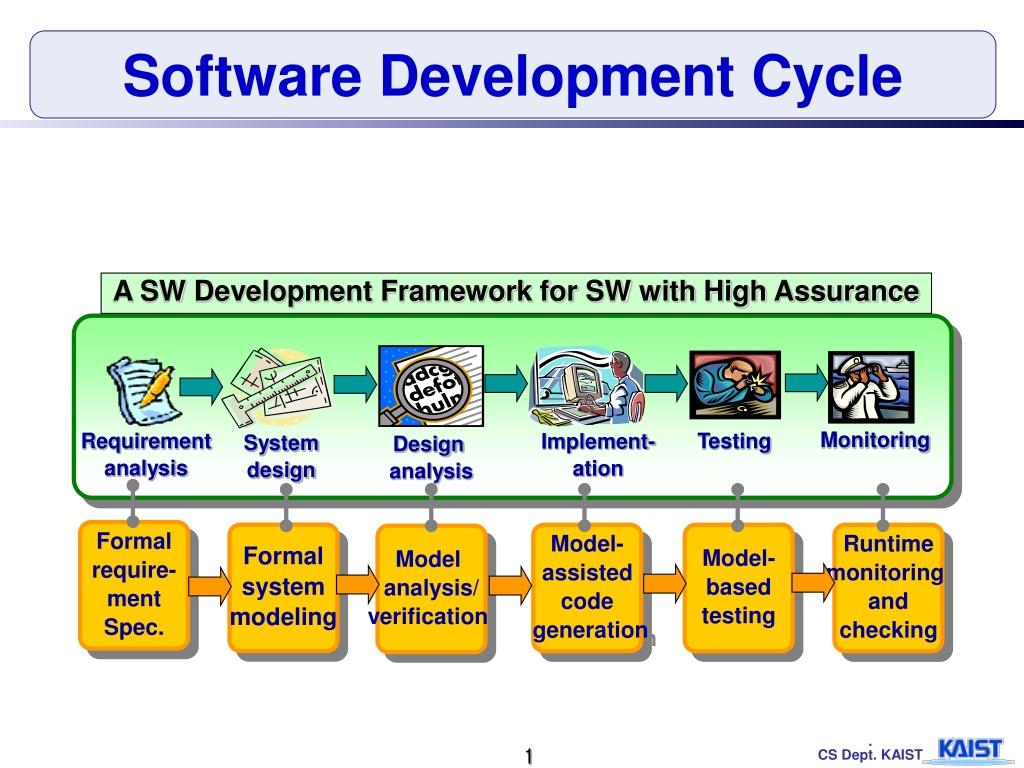
Advanced Software Development Frameworks and Testing Techniques
Explore the software development cycle, V-model, foundation of software testing, and black-box testing methodologies. Learn about functional testing goals and the category-partition method for test case generation.
Download Presentation

Please find below an Image/Link to download the presentation.
The content on the website is provided AS IS for your information and personal use only. It may not be sold, licensed, or shared on other websites without obtaining consent from the author. Download presentation by click this link. If you encounter any issues during the download, it is possible that the publisher has removed the file from their server.
E N D
Presentation Transcript
Software Development Cycle A SW Development Framework for SW with High Assurance Monitoring Requirement analysis Testing Implement- ation System design Design analysis Formal require- ment Spec. Model- assisted code generation Runtime monitoring and checking Formal system modeling Model- based testing Model analysis/ verification top_logo . CS Dept. KAIST 1 1
SW Development and Testing Model (a.k.a. V model) Manual Labor Abstraction Moonzoo Kim Provable SW Lab 2/42
Foundation of Software Testing Test oracle A pair of requirement spec and system design spec Spec 3. execution Program Test case Code that implements the system specification and satisfies the requirements A pair of test input and expected test output for the input Multiple targets for software testing 1. Does the test cases represent the requirement spec correctly? Scenario based testing (black-box testing) 2. Is the design spec implemented as program correctly? Model-based testing (grey-box testing) 3. Does the program satisfy test cases correctly? Code-based testing (white-box testing) 3 2025-03-18
Black Box Testing A main goal of testing is to generate multiple test cases, one of which may reveal a bug. Black box testing concerns only input/output of a target program (i.e., ignore program code) Ex1. Requirement specification based testing Ex2. Random (input generation) testing Ex3. Category partitioning method Ex4. T-way testing Advantage of black box testing Intuitive and simple Requires little expertise on program/code analysis techniques Requires less effort compared to white-box testing cheaper but less effective 4/11 Moonzoo Kim
Example of Blackbox Testing Technique: The Category-Partition Method for Specifying and Generating Functional Tests (Thomas J. Ostrand and Marc J.Balcer [ CACM,1988 ]) The original slides from Prof. Shmuel Sagiv s lecture notes msagiv@post.tau.ac.il
Content: Introduction. The category-partition method: - characteristics. - the method. - examples. Other methods.
The goal of functional testing To find discrepancies between the actual beha viorof the implemented system s function and the desired behavior as described in the syste m s functional specification.
How to achieve this goal ? Tests have to be execute for all the system fun ctions. Tests have to be designed to maximize the cha nces of finding errors in the software.
Functional test can be derived from 3 sour ces: 1. The software specification. 2. Design information. 3. The code itself.
Partition - The standard approach The main idea is to partition the input domain of function being tested, and then select test da ta for each class of the partition. The problem of all the existing techniques is the lack of systematic. Input domain p2 p1 a 2 16 y 4 i p3 p4 z 1 p 3 q 7
A strategy for test case generation 1. Transform the system s specification to be more concise and structured. 2. Decompose the specification into functionalunit - to be tested independently. 3. Identify the parameters and environment conditions.
A strategy for test case generation (cont) 4. Find categories that characterize each paramet er and environment condition. 5. Every category should be partitioned into distin ct choices . formal test specification
A strategy for test case generation (cont) ? 6. testframes - set of choices, one from each category. test cases - test frame with specific values for each choices. test scripts - sequence of test cases.
Example Command: find Syntax: find <pattern> <file> Function:The find command is used to locate one or more instance of a given pattern in a text file. All lines in the file that contain the pattern are written to standard output. A line containing the pattern is written only once, regardless of the number of times the pattern occurs in it. The pattern is any sequence of characters whose length does not exceed the ma ximum length of a line in the file .To include a blank in the pattern, the entire p attern must be enclosed in quotes ( ).To include quotation mark in the pattern , two quotes in a row ( ) must be used.
Example: find john myfile display lines in the file myfile which contain john find john smith in myfile display lines in the file myfile which contain john smith find john smith in myfile display lines in the file myfile which containjohn smith
Categories Parameters: Pattern size: empty single character many character longer than any line in the file Embedded quotes: no embedded quotes one embedded quotes several embedded quotes 3 4 Total Tests frames: 1944 (=4*3*3*3*3*3*2) File name: good file name no file with this name omitted Environments: Number of occurrence of pattern in file: none exactly one more than one 3 Quoting: pattern is not quoted pattern is improperly quoted pattern is quoted 3 Embedded blanks: no embedded blank one embedded blank several embedded blanks 3 3 Pattern occurrences on target line: one more than one 2
Adding Constraints between Categories to Reduce #of TC S Parameters: Pattern size: empty [ property Empty ] single character [ property NonEmpty ] many character [ property NonEmpty ] longer than any line in the file [ property NonEmpty ] Quoting: pattern is not quoted [ if NonEmpty ] pattern is improperly quoted [ if NonEmpty ] pattern is quoted [ property Quoted ] Embedded blanks: no embedded blank [ if NonEmpty ] one embedded blank [ if NonEmpty and Quoted ] several embedded blanks [ if NonEmpty and Quoted ]
Embedded quotes: no embedded quotes [ if NonEmpty ] one embedded quotes [ if NonEmpty ] several embedded quotes [ if NonEmpty ] File name: good file name no file with this name omitted Environments: Number of occurrence of pattern in file: none [ if NonEmpty ] exactly one [ if NonEmpty ] [ property Match] more than one [ if NonEmpty ] [ property Match ] Total Tests frames: 678 Pattern occurrences on target line: one [ if Match ] more than one [ if Match ]
Parameters: Pattern size: empty [ property Empty ] single character [ property NonEmpty ] many character [ property NonEmpty ] longer than any line in the file [ error ] Quoting: pattern is not quoted [ if NonEmpty ] pattern is improperly quoted [ error ] pattern is quoted [ property quoted ] Embedded blanks: no embedded blank [ if NonEmpty ] one embedded blank [ if NonEmpty and Quoted ] several embedded blanks [ if NonEmpty and Quoted ]
Embedded quotes: no embedded quotes [ if NonEmpty ] one embedded quotes [ if NonEmpty ] several embedded quotes [ if NonEmpty ] File name: good file name no file with this name [ error ] omitted [ single ] Total Tests frames: 125 40 Total Tests frames: Environments: Number of occurrence of pattern in file: none [ if NonEmpty ] exactly one [ if NonEmpty ] [ property Match] more than one [ if NonEmpty ] [ property Match ] [ single ] Pattern occurrences on target line: one [ if Match ] more than one [ if Match ] [ single ]
White Box Testing (1/2) White box testing concerns program code itself Many different viewpoints on program code program code as a graph (i.e., structural coverage) program code as a set of logic formulas (i.e., logical coverage) program code as a set of execution paths (i.e., behavioral/dynamic coverage) Advantages: More effective than blackbox testing in general Can measure the testing progress quantitatively based on coverage achieved Should be used with blackbox testing together for maximal bug detection capability Blackbox testing and whitebox testing often explore different segments of target program space 21/11 Moonzoo Kim
White Box Testing (2/2) Coverage is a good predictor/indicator of testing effectiveness Utilizing correlation between structural coverage and fault detection ability coverage metric A Fault finding coverage metric B coverage metric C Coverage
Bug Observability/Detection Model: Reachability, Infection, Propagation, and Revealation (RIPR) Graph coverage Test requirement satisfaction == Reachability the fault in the code has to be reached Logic coverage Test requirement satisfaction == Reachability +Infection the fault has to put the program into an error state. Note that a program is in an error state does not mean that it will always produce the failure Mutation coverage Test requirement satisfaction == Reachability +Infection + Propagation the program needs to exhibit incorrect outputs Furthermore, test oracle plays critical role to reveal failure of a target program (Revealation) Terminology Fault: static defect in a program text (a.k.a a bug) Error: dynamic (intermediate) behavior that deviates from its (internal) intended goal A fault causes an error (i.e. error is a symptom of fault) Failiure: dynamic behavior which violates a ultimate goal of a target program Not every error leads to failure due to error masking or fault tolerance

